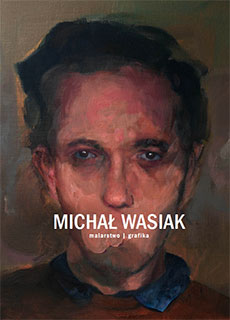 |
|
Michał Wasiak »
MALARSTWO, GRAFIKA


A Scarred Portrait
The set of pictorial motifs in Michał Wasiak’s
artwork is deliberately reduced. The young artist
focuses on human beings and the way of presenting
them is surprising.
If we were to look for historical sources of
inspiration, they would be, on the one hand, classic
works by masters of portraiture, and on the other,
the 20th century explorations by artists ranging from
surrealism to new figuration. The trends dominated
by expressiveness, the atmosphere of anxiety and
deformation. The art using allusions or symbols
stretched between cruelty and ridicule.
In the presented world of paintings and graphics
human figures appear – in paintings they are fuller, in
graphics they are represented only by heads. Michał
Wasiak has no intention to create their academic
images. The figures are distorted, their faces are
multiplied, twisted, dismembered. They look as if they
were scarred. We feel that behind the tissue drawn in
this way, which makes identification difficult, there
is a true human being, derealised or equipped with
mysterious attributes. We need to discover what is
hidden behind these incomplete quasi-human forms.
Escape from literalism and complex narrative
reinforces the feeling of emotional truth. Limiting the
range of created motifs, depriving the expression of
anecdote does not weaken the message at all. The
feeling of deficiency has been compensated with the
quality of the painterly image or the perfection of the
graphic print.
This can be seen very well in the series of
poignant mezzotints. This technique is considered to
be one of the most difficult ones and is sometimes
used as a measure of the graphic artist’s technical skills.
It eliminates linearity, typical of engraving, in favour of
the tonal patch, which makes it the most painterly of all
graphic techniques.
In the mezzotints by Michał Wasiak, human (and at
the same time non-human) heads emerge from a deep
backdrop which is a contrast for the whole set of subtle,
soft transitions from black to white. They are placed in
a space difficult to define, devoid of any characteristics.
The substance of the face itself is constructed on the
one hand by almost photographically rendered parts of
the human body, and on the other by surreal attributes
(blindfolds, layers of fibers) or signs (cracks, splits, cavities)
of external oppression.
In the case of many artists, the anxieties
expressed in this way become a testimony of the
search for one’s own identity – personal and creative.
They are aimed at understanding oneself and, at the
same time, at grasping man’s place in the world which
they are part of.
The artist has already experimented with
numerous techniques: etching, aquatint, mezzotint,
sugar-lift etching or cyanotype. Many works are
based on digitally created projects. The motifs
observed in nature are subject to the author’s original
transformations.
It can be observed that Michał Wasiak looks for suitable
tools to convey a certain scale of expression. The artist
skilfully uses features typical of a given technique to
achieve the intended expressive effect. For example,
the ferrotints, in which reflections of human types
and situations rather than specific figures appear, are
rougher, as if they were subject to stronger surface
interference; this creates the effect of indefiniteness
and distance.
Like in a poster, the flattened images of human faces
emerge from the white background, becoming the
signs of human condition, pictorial tools expressing
the state of sublimation or decline. Man, deprived of
context expressed in details and shown without any
signs of specificity and individuality, acquires almost
symbolic value.
In visual terms, the works, both painting and
graphic ones, create a space for reflection on the
formation of form and its deformation, up to the limits
of the object’s identifiability. Thanks to the assumed
idea imposed on the message, the series of painting
works corresponds with the graphic works. In the
paintings on canvas, the artist also shapes the portraits
of figures - in a series of more varied frames than
in the graphics - in order to perform on them an
operation of stripping them of both their physical and
emotional fullness. The form that builds the human
figure is a brilliantly sensed autonomous plastic value.
Deformations take place only within the very corporeal
matter of the objects, without endowing them with
additional symbolic accessories. The series of paintings
is very consistent when it comes to the use of light and
the choice of colour palette, dominated by red and
blue tones.
What strikes us in the works created by the
artist is the lack of unequivocally and conventionally
expressed emotions and feelings. We have only their
signs, their expression. Looking at Michał Wasiak’s
works we feel that the search for or definition
of identity is always marked with the odium of
incompleteness or imperfection. We are aware that in
the case of humans it is impossible to grasp what is
unambiguous, what constitutes a definable whole.
Dariusz Le¶nikowski
Transl. Elżbieta Rodzeń-Le¶nikowska

 KATALOG
KATALOG
|
|
|
 |










